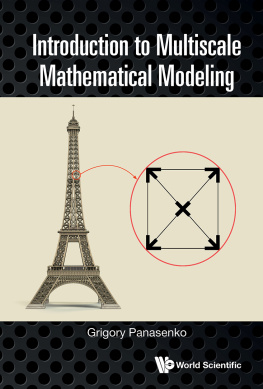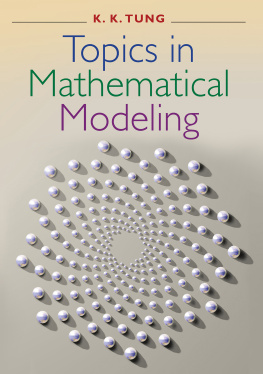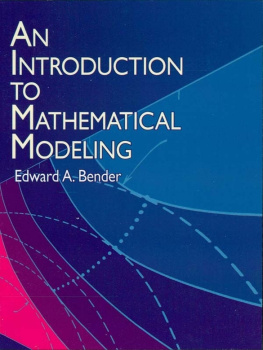Mark M. Meerschaert
Department of Statistics and Probability, Michigan State University, A430 Wells Hall, East Lansing, MI 48824-1027 USA
Copyright
Academic Press is an imprint of Elsevier
225 Wyman Street, Waltham, MA 02451, USA
525 B Street, Suite 1900, San Diego, CA 92101-4495, USA
The Boulevard, Langford Lane, Kidlington, Oxford OX5 1GB, UK
Radarweg 29, PO Box 211, 1000 AE Amsterdam, The Netherlands
Fourth edition 2013
Copyright 2013, Elsevier Inc. All rights reserved.
No part of this publication may be reproduced, stored in a retrieval system or transmitted in any form or by any means electronic, mechanical, photocopying, recording or otherwise without the prior written permission of the publisher.
Permissions may be sought directly from Elseviers Science & Technology Rights Department in Oxford, UK: phone (+44) (0) 1865 843830; fax (+44) (0) 1865 853333; , and selecting Obtaining permission to use Elsevier material.
Notices
No responsibility is assumed by the publisher for any injury and/or damage to persons or property as a matter of products liability, negligence or otherwise, or from any use or operation of any methods, products, instructions or ideas contained in the material herein.
Library of Congress Cataloging-in-Publication Data
Meerschaert, Mark M., 1955-Mathematical modeling / Mark M. Meerschaert. 4th ed.
p. cm.
Includes index.
ISBN 978-0-12-386912-8
1. Mathematical models. I. Title.
QA401.M48 2013
511.8dc23
2012037454
British Library Cataloguing-in-Publication Data
A catalogue record for this book is available from the British Library
ISBN: 978-0-12-386912-8
For information on all Academic Press publications visit our web site at store.elsevier.com
Printed and bound in USA
13 14 15 16 17 10 9 8 7 6 5 4 3 2 1

Preface
Mark M. Meerschaert, Department of Statistics and Probability, Michigan State University, C430 Wells Hall, East Lansing, MI 48824-1027 USA, Phone: (517) 353-8881, Fax: (517) 432-1405,
Mathematical modeling is the link between mathematics and the rest of the world. You ask a question. You think a bit, and then you refine the question, phrasing it in precise mathematical terms. Once the question becomes a mathematics question, you use mathematics to find an answer. Then finally (and this is the part that too many people forget), you have to reverse the process, translating the mathematical solution back into a comprehensible, no-nonsense answer to the original question. Some people are fluent in English, and some people are fluent in calculus. We have plenty of each. We need more people who are fluent in both languages and are willing and able to translate. These are the people who will be influential in solving the problems of the future.
This text, which is intended to serve as a general introduction to the area of mathematical modeling, is aimed at advanced undergraduate or beginning graduate students in mathematics and closely related fields. Formal prerequisites consist of the usual freshman-sophomore sequence in mathematics, including one-variable calculus, multivariable calculus, linear algebra, and differential equations. Prior exposure to computing and probability and statistics is useful, but is not required.
Unlike some textbooks that focus on one kind of mathematical model, this book covers the broad spectrum of modeling problems, from optimization to dynamical systems to stochastic processes. Unlike some other textbooks that assume knowledge of only a semester of calculus, this book challenges students to use all of the mathematics they know (because that is what it takes to solve real problems).
The overwhelming majority of mathematical models fall into one of three categories: optimization models; dynamic models; and probability models. The type of model used in a real application might be dictated by the problem at hand, but more often, it is a matter of choice. In many instances, more than one type of model will be used. For example, a large Monte Carlo simulation model may be used in conjunction with a smaller, more tractable deterministic dynamic model based on expected values.
This book is organized into three parts, corresponding to the three main categories of mathematical models. We begin with optimization models. A five-step method for mathematical modeling is introduced in Section 1 of covers some important computational techniques, including Newtons method in one and several variables, and linear and integer programming.
In the next part of the book, on dynamic models, students are introduced to the concepts of state and equilibrium. Later discussions of state space, state variables, and equilibrium for stochastic processes are intimately connected to what is done here. Nonlinear dynamical systems in both discrete and continuous time are covered. There is very little emphasis on exact analytical solutions in this part of the book, since most of these models admit no analytic solution. At the end of is a section on chaos and fractals that was added in the second edition. We use both analytic and simulation methods to explore the behavior of discrete and continuous dynamic models, to understand how they can become chaotic under certain conditions. This section provides a practical and accessible introduction to the subject. Students gain experience with sensitive dependence to initial conditions, period doubling, and strange attractors that are fractal sets. Most important, these mathematical curiosities emerge from the study of real-world problems.
Finally, in the last part of the book, we introduce probability models. No prior knowledge of probability is assumed. Instead we build upon the material in the first two parts of the book, to introduce probability in a natural and intuitive way as it relates to real-world problems.. The first new section covers particle tracking methods, for solving partial differential equations via Monte carlo simulation of the underlying stochastic process. The final section of the book introduces fractional calculus in the context of anomalous diffusion. The fractional diffusion equation is solved by particle tracking, and applied to a problem in ground water pollution. This section ties together the concepts of fractals, fractional derivatives, and probability distributions with heavy tails.
Each chapter in this book is followed by a set of challenging exercises. These exercises require significant effort, as well as a certain amount of creativity, on the part of the student. I did not invent the problems in this book. They are real problems. They were not designed to illustrate the use of any particular mathematical technique. Quite the opposite. We will occasionally go over some new mathematical techniques in this book because the problem demands it. I was determined that there would be no place in this book where a student could look up and ask, "What is all of this for?" Although typically oversimplified or grossly unrealistic, story problems embody the fundamental challenge in applying mathematics to solve real problems. For most students, story problems present plenty of challenge. This book teaches students how to solve story problems. There is a general method that can be applied successfully by any reasonably capable student to solve any story problem. It appears in , Section 1. This same general method is applied to problems of all kinds throughout the text.







